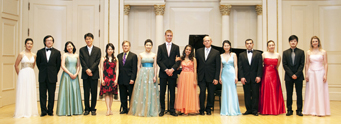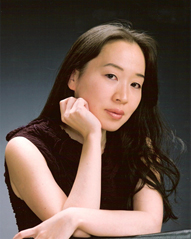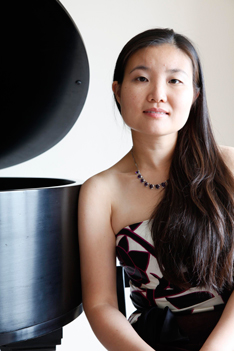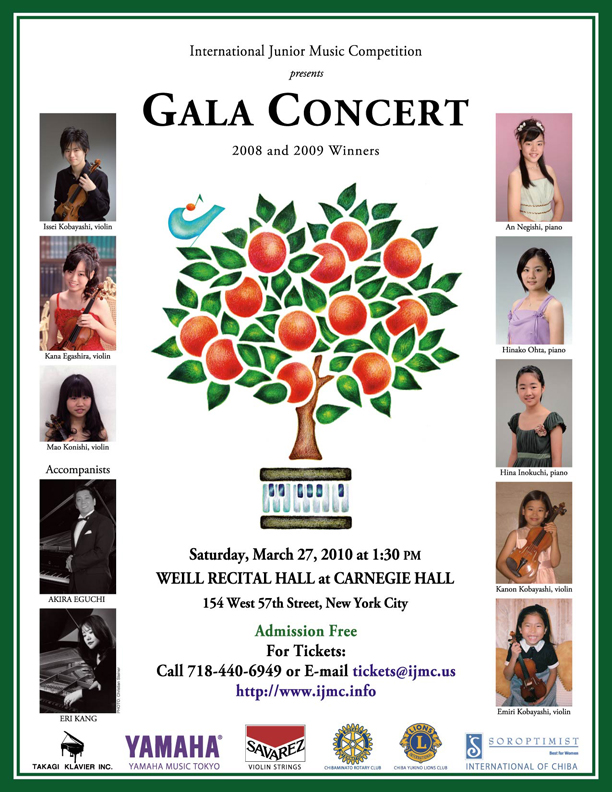There has certainly been no shortage of Chopin and Schumann celebrations this year, but a gala concert by Min Kwon and musicians from the Mason Gross School of the Arts showed that there is always room for another. Sixteen musicians of various ages (both faculty and students) assembled in a large and varied recital of well-loved works by the two masters. The program’s first half was a bit long (well over an hour), but the programming was a delight (alternating the two composers instead of placing them in large blocs), and the dovetailed entries and exits kept the flow.
The first offering was Chopin’s Scherzo in B minor, played by undergraduate Lachlan Glen. A bold opening by a young pianist with promise, the piece enjoyed increased confidence and accuracy as it proceeded. Recent freshman Michelle Rofrano followed with Chopin’s Waltzes in F Minor, Op. 70, No. 2 and C-sharp minor, Op. 64, No. 2. Graceful and earnest, her readings caught much of the works’ beauties. Moving to Schumann songs, we heard “Er Ist’s” (“It is Spring”) and “Stille Tränen” (“Silent Tears”) sung by soprano Catherine Spadora Stebbins with Barbara González-Palmer at the piano. An M.M. candidate, Ms. Stebbins has an appealing voice and projected the contrasting moods well.
Returning to the piano, the program continued with Chopin’s Etudes, the C Major, Op. 10, No. 1 and C Minor, Op. 10, No. 12 (“Revolutionary”) played by doctoral student Zin Bang. These were unusually solid and confident performances, showing admirable technical control. When doctoral student Kelly Yu-Chieh Lin followed with Chopin’s Nocturne in C minor, Op. 48, No. 1, one was ready for something meditative and received just that. Ms. Lin sustained her melodic lines beautifully in the opening’s profound simplicity and over surging left hand octaves. Having once had the pleasure of reviewing doctoral student, Alexander Beridze, I was eagerly anticipating his Chopin Ballade in F Major (the Ballade dedicated to Schumann). At first, the contrasts between the lyrical and tempestuous sections seemed a bit restrained; upon reflection, though, the avoidance of what some pianists turn into excess would likely have pleased its most elegant composer. Mr. Beridze did not disappoint. The infamous coda lacked nothing in speed and excitement.
A highlight of the evening was the playing of doctoral student Junko Ichikawa, who performed Chopin’s Mazurka in A-flat Major, Op. 24, No. 3 and Waltz in A-flat major, Op. 42 with ease and maturity. Especially impressive was her imaginative use of contrasting articulations and pedaling to enliven the various restatements.
More Schumann songs followed, “Der Nussbaum” (“The Nut Tree”) and “Widmung” (“Dedication”) both from the composer’s Op. 25. Hong Kyung Kim was the expressive soprano with Ms. González-Palmer providing important support. Two Chopin Mazurkas, with melodies that Schumann called “cannons hidden in fields of flowers” came next. The A-flat major and F-sharp minor Mazurkas from Op. 59, were given thoughtful, understated interpretations by doctoral student DiYi Tang. Finishing the half was Miao Hou (soon to enter the DMA program at Mason Gross) in a rousing, dynamic performance of Chopin’s Scherzo No. 2 in B-flat minor.
The second half consummated the celebration with some of the more seasoned performers and faculty, including violinists Todd Phillips and Leo Ching-Hung Lo, violist Audrey Ching-Yuan Chen, cellist Jonathan Spitz, and pianist Min Kwon in Schumann’s Piano Quintet in E-flat. Ms. Kwon, who had supervised and greeted earlier that evening, proved to be the tireless center of a vibrant performance. Some highlights included singing cello melodies in the first movement and a Scherzo that absolutely pulsated with life. Happy 200th indeed!



 Victor Goldberg is an excellent pianist with a formidable technique, a powerful tone, and a romantic soul (and a distracting habit of tossing his hands way up). Russian-born, he has studied, performed and won competitions in Europe, Israel and America, and is the recipient of the 2008 Pro Musicis International Award.
Victor Goldberg is an excellent pianist with a formidable technique, a powerful tone, and a romantic soul (and a distracting habit of tossing his hands way up). Russian-born, he has studied, performed and won competitions in Europe, Israel and America, and is the recipient of the 2008 Pro Musicis International Award.
 Mana Takuno’s excellent performance of an early, rarely heard 1901 work by George Enescu, his Suite No.2 in D Major, Op. 10, delighted me at a May 8, 2008 concert—(see review in Volume 15, No.3 of this journal) , and it made me want to hear more of her playing. I wrote that her exciting interpretation, with its “drive, virtuosity, textual and coloristic diversity”, stole the show from three other young pianists who shared the same concert with her. Ms. Takuno and her program of Poulenc, Thomas Oboe Lee, Beethoven and Schumann afforded me a more comprehensive “fix” on her achievement and pianistic capabilities.
Mana Takuno’s excellent performance of an early, rarely heard 1901 work by George Enescu, his Suite No.2 in D Major, Op. 10, delighted me at a May 8, 2008 concert—(see review in Volume 15, No.3 of this journal) , and it made me want to hear more of her playing. I wrote that her exciting interpretation, with its “drive, virtuosity, textual and coloristic diversity”, stole the show from three other young pianists who shared the same concert with her. Ms. Takuno and her program of Poulenc, Thomas Oboe Lee, Beethoven and Schumann afforded me a more comprehensive “fix” on her achievement and pianistic capabilities.